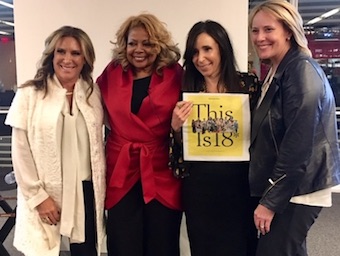The imbalance between men and women at the top levels of the business world was the topic of a New York Women in Communications event on Oct. 18.
“Power of the Pack” featured The Female Quotient CEO Shelley Zalis and New York Times executive vice president, chief operating officer Meredith Kopit Levin in a discussion moderated by Weber Shandwick senior vice president, diversity & inclusion Judith Harrison. Harrison is also president of New York Women in Communication.
 From left: Shelley Zalis, Judith Harrison, Meredith Kopit Levin and Bloomberg Deputy Chief Operating Officer Jacki Kelley. |
Harrison noted that women make up just four percent of Fortune 500 CEOs and cited a study that said it would take 217 years for women to achieve workplace equality. She then asked Zalis and Levin why the equality gap is so big and why it is projected that closing it will take so long.
Zalis said one reason for the persistence of inequality is that “we've not been creating solutions for change.” For example, she said that women still sell themselves short when it comes to asking for the salaries they deserve.
“We all know the facts that women are paid on past performance,” she said. “So we’ve been making less, and you come to your job interview. They say, ‘What did you make at your last job?’ and when you say $50,000, they say ‘OK we'll give you 55’ and you’re supposed to say that’s awesome.”
Other hurdles that were mentioned include the lack of family leave, the prevalence of sexual misbehavior toward women, and ageism.
Levin said that, in terms of dealing with the effects of ageism, “literally reskilling yourself all the time to be able to do the new thing, is the most important thing and finding a community of people who will introduce you based on the skills that you have.”
Zalis, Levin and Harrison all agreed that it’s time the rules affecting women in the workplace changed.
“Let’s level the playing field,” Zalis said. “Look at culture and values and policies. Let’s pick policies that work for everyone to thrive in the workplace.”


 “The Value of PR” was the theme of this year’s Communications Week, which included events in New York, Chicago, London and Germany that ran from Oct. 14 to 18.
“The Value of PR” was the theme of this year’s Communications Week, which included events in New York, Chicago, London and Germany that ran from Oct. 14 to 18. Harold Burson's passion for client service, insatiable curiosity, humility and rock solid values are why the Memphis native is a PR legend, said Pat Ford, ex-vice chairman of B-M, at last night's unveiling of the Museum of Public Relations' collection of papers and mementoes of the 98-year-old executive. (2 reader comments)
Harold Burson's passion for client service, insatiable curiosity, humility and rock solid values are why the Memphis native is a PR legend, said Pat Ford, ex-vice chairman of B-M, at last night's unveiling of the Museum of Public Relations' collection of papers and mementoes of the 98-year-old executive. (2 reader comments) Musem of Public Relations celebrates some of the industry's first female leaders... IPR is hosting 2019 Bridge PR and Communications Conference in April... USC Annenberg event to look at the future of technology in communications.
Musem of Public Relations celebrates some of the industry's first female leaders... IPR is hosting 2019 Bridge PR and Communications Conference in April... USC Annenberg event to look at the future of technology in communications. Museum of PR slates fourth annual BlackPRHistory event on Jan. 30... Slate PR partners with GLADD in presenting annual awards gala May 4 in NYC... New York Women in Communications schedules career change session Jan. 31.
Museum of PR slates fourth annual BlackPRHistory event on Jan. 30... Slate PR partners with GLADD in presenting annual awards gala May 4 in NYC... New York Women in Communications schedules career change session Jan. 31. Five rising stars in the communications industry were honored at the sixth annual New York Women in Communications "WiCi Awards” ceremony.
Five rising stars in the communications industry were honored at the sixth annual New York Women in Communications "WiCi Awards” ceremony. 


 Have a comment? Send it to
Have a comment? Send it to 
No comments have been submitted for this story yet.